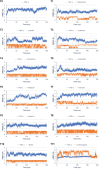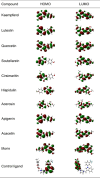Dual therapeutic potential of Scoparia dulcis in combating hyperglycemia and inflammation in diabetes through network pharmacology and in silico analysis
- PMID: 40596421
- PMCID: PMC12217303
- DOI: 10.1038/s41598-025-06862-5
Dual therapeutic potential of Scoparia dulcis in combating hyperglycemia and inflammation in diabetes through network pharmacology and in silico analysis
Abstract
Chronic low-grade inflammation is a key contributor to the pathogenesis and complications of diabetes, leading to issues such as joint pain, skin disorders, periodontal disease, and neuropathy. Therefore, targeting inflammatory pathways has emerged as a promising therapeutic strategy for both the prevention and management of diabetes and its associated comorbidities. Natural products with dual anti-inflammatory and antidiabetic properties have gained significant interest, with Scoparia dulcis showing notable therapeutic potential. This study aimed to evaluate the efficacy of this herbal medicine in alleviating inflammation in diabetic patients using an integrative in silico approach, incorporating network pharmacology, molecular docking, and molecular dynamics simulations. Initial screening of compounds focused on their ability to inhibit key pathological targets implicated in diabetes-related inflammation. Pathway enrichment analysis revealed significant involvement in the AGE-RAGE signaling pathway, lipid metabolism, atherosclerosis pathways, and the hypoxia-inducible factor 1 (HIF-1) pathway. Ten critical molecular targets were identified, with TNF-α being the most prominent. Molecular docking followed by 200 ns molecular dynamics simulations assessed the binding affinity of TNF-α with the top ten selected compounds, revealing strong and stable interactions with essential active site residues. Furthermore, ADMET analysis and density functional theory (DFT) evaluations highlighted the therapeutic potential of these compounds as promising lead candidates for drug development. Existing literature supports the antidiabetic effects of these bioactive compounds, reinforcing the in silico findings. Thus, Scoparia dulcis represents a potential adjunct or alternative therapy for diabetic patients with chronic inflammation, offering a multifaceted approach to disease management.
Keywords: DFT; Diabetes mellitus; Docking; Inflammation; Molecular dynamics; Network Pharmacology.
© 2025. The Author(s).
Conflict of interest statement
Declarations. Competing interests: The authors declare no competing interests.
Figures









Similar articles
-
Anti-inflammatory potential of Grewialin from Grewia optiva: insights from molecular docking, ADMET, DFT, and in-vitro studies.J Comput Aided Mol Des. 2025 Jul 23;39(1):56. doi: 10.1007/s10822-025-00632-1. J Comput Aided Mol Des. 2025. PMID: 40699260
-
The HIF-1α signaling pathway: A key approach to revealing the effects of Scutellaria baicalensis Georgi against lipopolysaccharide-induced spontaneous abortion.Phytomedicine. 2025 Sep;145:157013. doi: 10.1016/j.phymed.2025.157013. Epub 2025 Jun 19. Phytomedicine. 2025. PMID: 40580693
-
Exploring Type II Diabetes Inhibitors from Genus Daphne Plant-species: An Integrated Computational Study.Comb Chem High Throughput Screen. 2025;28(8):1413-1442. doi: 10.2174/0113862073262227231005074024. Comb Chem High Throughput Screen. 2025. PMID: 38584562
-
Systemic pharmacological treatments for chronic plaque psoriasis: a network meta-analysis.Cochrane Database Syst Rev. 2017 Dec 22;12(12):CD011535. doi: 10.1002/14651858.CD011535.pub2. Cochrane Database Syst Rev. 2017. Update in: Cochrane Database Syst Rev. 2020 Jan 9;1:CD011535. doi: 10.1002/14651858.CD011535.pub3. PMID: 29271481 Free PMC article. Updated.
-
Systemic pharmacological treatments for chronic plaque psoriasis: a network meta-analysis.Cochrane Database Syst Rev. 2021 Apr 19;4(4):CD011535. doi: 10.1002/14651858.CD011535.pub4. Cochrane Database Syst Rev. 2021. Update in: Cochrane Database Syst Rev. 2022 May 23;5:CD011535. doi: 10.1002/14651858.CD011535.pub5. PMID: 33871055 Free PMC article. Updated.
References
-
- Olowosoke, C. B. et al. Investigation of polymorphism role in protein structure and function for selected cancer and diabetes disease; A rationale to selection of targets for insilico drug screening. Inf. Med. Unlocked. 42, 101342. 10.1016/j.imu.2023.101342 (2023).
-
- Lontchi-Yimagou, E., Sobngwi, E. & Matsha, T. E. Kengne diabetes mellitus and inflammation. Curr. Diab Rep.13 (3), 435–444. 10.1007/s11892-013-0375-y (2013). - PubMed
-
- Le, H. G. et al. Investigating the therapeutic potential of terpene metabolites in hot-natured herbal medicines and their mechanistic impact on circulatory disorders. Phytochem Rev.10.1007/s11101-025-10074-0 (2025).
MeSH terms
Substances
LinkOut - more resources
Full Text Sources
Medical
Miscellaneous

